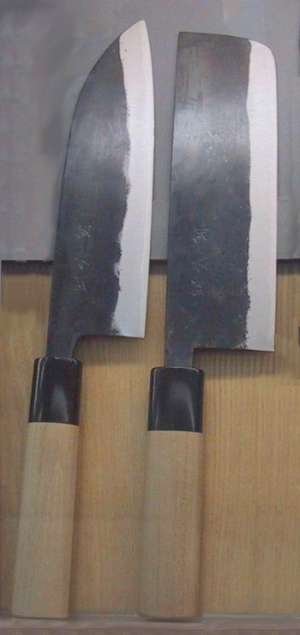Nakiri bōchō on:
[Wikipedia]
[Google]
[Amazon]

 ''Nakiri bōchō'' ( 菜切り包丁, translation: knife for cutting greens) and ''usuba bōchō'' ( 薄刃包丁, thin knife) are Japanese-style
''Nakiri bōchō'' ( 菜切り包丁, translation: knife for cutting greens) and ''usuba bōchō'' ( 薄刃包丁, thin knife) are Japanese-style

vegetable
Vegetables are parts of plants that are consumed by humans or other animals as food. The original meaning is still commonly used and is applied to plants collectively to refer to all edible plant matter, including the flowers, fruits, stems, ...
knives
A knife ( : knives; from Old Norse 'knife, dirk') is a tool or weapon with a cutting edge or blade, usually attached to a handle or hilt. One of the earliest tools used by humanity, knives appeared at least 2.5 million years ago, as evidenced ...
. They differ from the '' deba bōchō'' in their shape, as they have a straight blade edge suitable for cutting all the way to the cutting board without the need for a horizontal pull or push. These knives are also much thinner. While the ''deba bōchō'' is a heavy blade for easy cutting through thin bones, the blade is not suitable for chopping vegetables, as the thicker blade can break the vegetable slice. The ''nakiri bōchō'' and the ''usuba bōchō'' have a much thinner blade. This does not help with cutting small bones in fish or meat, but is useful for cutting vegetables.
''Nakiri bōchō'' are knives for home use, and sometimes have a black finished, or Kurouchi, blade. The cutting edge is angled from both sides, called '' ryōba'' in Japanese. This makes it easier to cut straight slices.
'' Usuba bōchō'' are vegetable knives used by professionals. They differ from the ''Nakiri bōchō'' in the shape of the cutting edge. While the ''nakiri bōchō'' is sharpened from both sides, the ''usuba bōchō'' is sharpened only from one side, a style known as ''kataba'' in Japanese. The highest quality ''kataba'' blades have a slight depression on the flat side. This ''kataba'' style edge gives better cuts and allows for the cutting of thinner slices than the ''ryōba'' used for ''nakiri bōchō'', but requires more skill to use. The sharpened side is usually the right side for a right hand use of the knife, but knives sharpened on the left side are available for left hand use. The ''usuba bōchō'' is heavier than a ''nakiri bōchō'', although still much lighter than a '' deba bōchō''.
See also
* Japanese kitchen knives *List of Japanese cooking utensils
The following items are common Japanese cooking tools used in preparing Japanese cuisine. For a list of general cooking tools see the list of food preparation utensils.
Knives
*''Deba bōchō'': kitchen carver for meat and fish
*'' Fugu hiki'', ...
References
{{DEFAULTSORT:Nakiri bocho Japanese kitchen knives ja:菜切り包丁